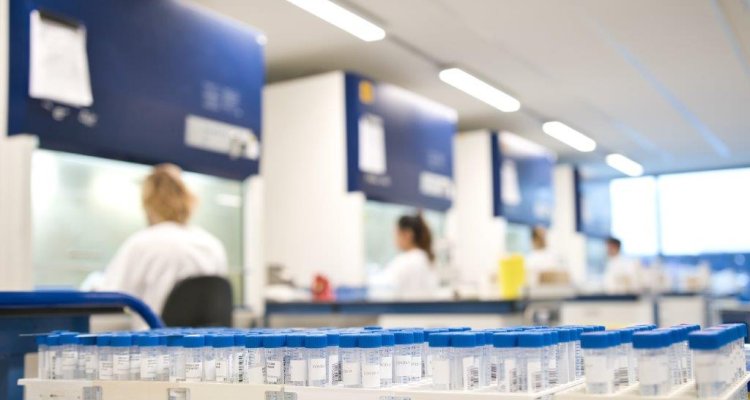
Coronavirus
A large variety of coronaviruses exist naturally and can cause diseases in many animal species. Several coronaviruses are zoonoses: they are able to infect humans. SARS-CoV-2 transferred from animals to humans in Wuhan (China) late 2019, and is responsible for the COVID-19 disease.
Wageningen Bioveterinary Research (WBVR) conducts research on infectious animal diseases in the Netherlands. When an unknown zoonosis – such as the SARS-coronavirus in 2019 – emerges, WBVR has the capacity to research it rapidly. Samples of a suspect animal (species) are analysed using a diagnostics pipeline created by WVBR for rapid detection of new pathogens.
WVBR contributes to combatting and preventing the coronavirus and COVID-19 in several ways.
1. Diagnostics in animals
WBVR has diagnostic tests available to test animals for coronavirus. These tests are carried out exclusively in emergency situations and in consultation with the NVWA. Globally, a few cases of domesticated pets sensitive to the coronavirus have been reported. In the Netherlands COVID-19 infections on mink farms were found; WBVR tested these animals and confirmed the infections. Further study is necessary to find out which other animals can be affected by the virus and to what degree.
In collaboration with several partners we have developed diagnostic tests to show coronavirus infection as well as antibodies in various animal species.
2. Vaccine development
Together with Utrecht University and Intravacc, WBVR is developing an intranasal vaccine against coronavirus. The vaccine will consist of a Newcastle disease virus (NDV) vector that expresses the immunogenic spike (S) protein of SARS-CoV-2. The viral vector technology and animal facilities of WBVR are used for this.
3. Testing vaccines and antivirals
WBVR and the Coalition for Epidemic Preparedness Innovations (CEPI) collaborate on mitigating and preventing coronavirus. WBVR is tasked with developing preclinical models for SARS-CoV-2, which will allow vaccines and antiviral therapeutics to be tested for efficacy and safety. Our experts have developed a COVID-19 model in hamsters. WBVR also offers virus neutralization tests (VNTs) against SARS-CoV-2 variants.
4. Testing disinfectants
WBVR designs methods to evaluate the efficacy of disinfectants to inactivate different coronaviruses.
5. (Inter)national collaboration and sharing expertise
- WBVR participates in the World Health Organisation (WHO) COVID-19 working group tasked with developing animal models that can be used to evaluate the efficacy and safety of new vaccines.
- Wageningen University & Research (and with it, WVBR) is a partner to the Netherlands Centre for One Health (NCOH). This open innovation network is running the study 'Fighting COVID-19 in animals and humans'.
- WBVR is part of the COVID-19 animal disease expert group of the Ministry of Agriculture, Nature and Food Quality (LNV).
- In the Dutch Signalling Forum Zoonoses (Dutch acronym SOZ), veterinary researchers, among which WBVR, regularly consult with public health researchers of the RIVM (National Institute for Public Health and Environment) and the GGD (Municipal Health Services).
- WBVR experts are member of the OMT-Z (Outbreak Management Team Zoonoses) to discuss developments for the control of outbreaks of zoonoses.
Coronavirus questions and answers
What animals are affected by the coronavirus?
A large variety of coronaviruses occurs in nature. These viruses are capable of causing many animal diseases. For example, canine coronavirus (CCV) in dogs, feline corona (FCV) in cats, porcine epidemic diarrhoea virus (PEDV), transmissible gastroenteritis virus (TGEV) and porcine respiratory coronavirus (PRCV) in pigs and infectious bronchitis virus (IBD) in chickens. These viruses are species-specific and are not transferable to humans.
Does every bat carry the coronavirus?
There are 1200 bat species around the world, and they are numerous: bats make up a quarter of all mammals. Bats tolerate viruses. Viruses present in their systems are not combatted, nor do they cause disease. In its natural environment, bats can pass the virus on to a host by biting, faeces or blood. Each bat species is sensitive to a particular spectrum of viruses. The Chinese horseshoe bat is suspected of carrying SARS-CoV-2. Previously, this bat has been known to carry viruses with a high degree of similarity, such as SARS.
Are all coronaviruses dangerous in humans?
In humans, coronaviruses usually just cause the common cold. However, coronaviruses that are transferred from animals to humans can indeed cause serious ailments. Previously, this happened with the coronaviruses that cause SARS and MERS, both serious respiratory infections that are potentially lethal in humans, as well as in 2019/2020 with SARS-CoV-2.
How did the present SARS-CoV-2 virus originate?
Results of studies indicate that the first patients contracted the virus at a market in Wuhan (China). A virus bearing similarities to SARS-CoV-2 was found in the exotic pangolin. This animal is sometimes illegally hunted and traded in China. The virus may possibly have been passed to humans from bats through this intermediary host. The virus then spread from human to human through the air and contact with infected surfaces.
Can pets become infected?
The chance that (farm) animals become infected with the SARS-CoV-2 coronavirus is very small. Research attempts to infect pigs and chickens with the virus have failed. A few cases of dogs infected with the virus have been reported. Cats appear to be more vulnerable. In the Netherlands, mink from several mink farms were infected. There are possible infections from mink to employees. Mink on the infected farms will be culled. Pet owners and other animal keepers are advised to adhere to general hygiene measures and to delegate the care of animals to others when showing symptoms of COVID-19.
Can food become contaminated?
In some slaughterhouses in the Netherlands, cases of employees infected by coronavirus were identified. There is no evidence that food, such as meat, is a source of the transmission of the coronavirus. The virus needs humans or animals to stay alive and grow. That is not possible in food. In addition to this, currently no coronavirus infections are known in for example, pigs, cows and poultry.